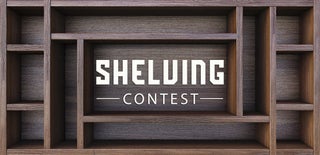Introduction: Cabinet Bookshelf
When a store purchased bookshelf isn't enough to accommodate your needs, a custom built bookshelf could be an option. There are numerous methods for construction. The steps below is how I chose to construct this cabinet bookshelf. Some items can be worked on in a different sequence. For example, if building the doors, they can be completed before painting. Thank you for viewing. I pray this is helpful to someone.
Step 1: Planning/Design & Preparation
Determining the area for construction will provide for the dimensions. Figuring out the materials to be used beforehand can help on material cost and can save on time during the build. Since this was going to be painted I used 4x8x3/4 sheets with a smooth finish on 1 side. The other side would be smooth enough to sand and fill with putty, spackle or a product such as Rockhard. To start, I removed the baseboard and drew what was to be designed on the walls. I do this to help with the overall design and during the construction process to make sure what I am building is within the original dimensions. It is not necessary to do this.
Step 2: Building the Framework
After reviewing the dimensions and figuring the possible weight of the bookshelf I decided it was best to frame an exoskeleton for the cabinets that will support the bookshelves. I was going to use 2x4's to do this. I picked up the 2x4's and measured and cut the appropriate sizes and screwed everything together. (In hindsight I could have used 2x6's for the bottom part to account for the existing trim that was to be used on the bottom front.)
Step 3: Building the Cabinets & Bookshelves
I measured what would be needed for the 4x8's. Went to Home Depot and picked up the 4x8's. I had most of the cuts done in the store since I am working alone on this. I brought them back to the work area and began to place the 4x8 cuts in their appropriate places. I then built the bookshelves and cut the outlets. To cut the outlets I removed one side of each bookshelf to dry fit the placement of the outlets. I find this easier then lifting the entire bookshelf in place. Then I placed the bookshelves on the cabinet and secured everything together using trim screws. When everything was aligned I connected it to the wall with 3 1/2 inch screws.
Step 4: Trim
Measured and cut the pieces to be used for the trim work. Fastened with screws the cabinet and bookshelf pieces. Cut the baseboard and shoe molding. Had to shorten the baseboard due to the height of the flooring. The original baseboard was put down before the flooring.
Step 5: Doors, Patching & Painting
Filled in all the holes and imperfections with putty and spackle. When dry sanded until smooth. Caulked all the places the boards connected to fill in any gaps. Painted one coat then patched any places needing additional work. While waiting for the paint to dry I worked on the doors. I cut them to size, routed them and then secured them in place. To make the holes I used a kreg tool. Did a light sand then painted a second coat.
Step 6: Final Adjustments
Adjusted the doors one last time to make sure each one closed correctly and were level with eachother. Then added the clear bumpers to each door. Any additional hardware required can be added now. The cabinet bookshelf is now complete.

Runner Up in the
Shelving Contest











